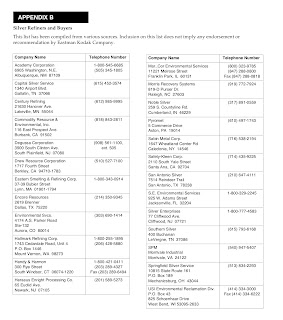First, get to know your facility’s drainage system. Does your facility belong to a sewage system or septic? USEPA Regulations differ for each system, thus your disposal options depend upon this entirely. In general, septic tanks do not have the ability to treat the photochemical waste you would be flushing. Luckily, there are many ways to otherwise transport your waste to a treatment plant etc. Check in your yellow pages, “google” for Hazardous Waste Collection, or bring them yourself. If you are part of a sewage system, the best method is to send them to the treatment plant via none other than the sewer. Spent developer, water used as stop bath and sepia toners are all OK to send down the drain. Fixer is NOT OK.
NOTE: Make sure that before you dispose of waste chemicals that they have been utilized to their full potential. Developer is usually good for multiple sessions, as long as stored properly (effects vary by dilution and brand). The more you reuse, the less you have to buy, and the less unnatural material you put into the environment!
Used fixer presents the largest problem in terms of disposal because after the development process, the liquid is saturated with silver ions. Silver over certain concentrations is regulated from entering the water table, as the properties of silver are such that it is toxic to aquatic wildlife. Even the amount used in a small darkroom often exceeds this concentration, and is thus illegal to flush down the drain as is, and also detrimental to the environment. Luckily, there are many ways to recover the silver from the fixer, thus conserving and recycling a valuable resource, as well as preventing any environmental damage that would be caused otherwise.
THE BEST METHODS FOR SILVER EXTRACTION DEPENDS UPON THE SIZE OF YOUR DARKROOM:
For smaller in-home or school operations: For a DIY kind of procedure, pour the used fixer into an appropriately sized bucket along with some steel wool. Leave the bucket overnight. In the morning, the silver will have conglomerated into a sludge while the effluent fixer can then be flushed. The silver sludge must then be collected, stored and eventually sent to a refinery to be recycled.
Another, slightly less intensive option is to do some research and find the closest larger photographic operation near you. Chances are that they have a system already in place to recover and perhaps refine the silver and are often willing to take your fixer for a certain percentage of the silver afterwards. Some likely culprits: large universities, hospitals, and commercial printers.
For larger commercial operations: Investment in a silvery recovery machine might be the most cost effective and easiest way to extract the silver. After recovery is complete, cartridges can then also be sent to refiners to be recycled.
Some helpful links:
Silver Profit - a leading manufacturer of silver recovery machines. Also has custom silver recovery buckets for a home operation
Kodak List of Silver Recovery – Major recovery facilities nationwide:

No comments:
Post a Comment